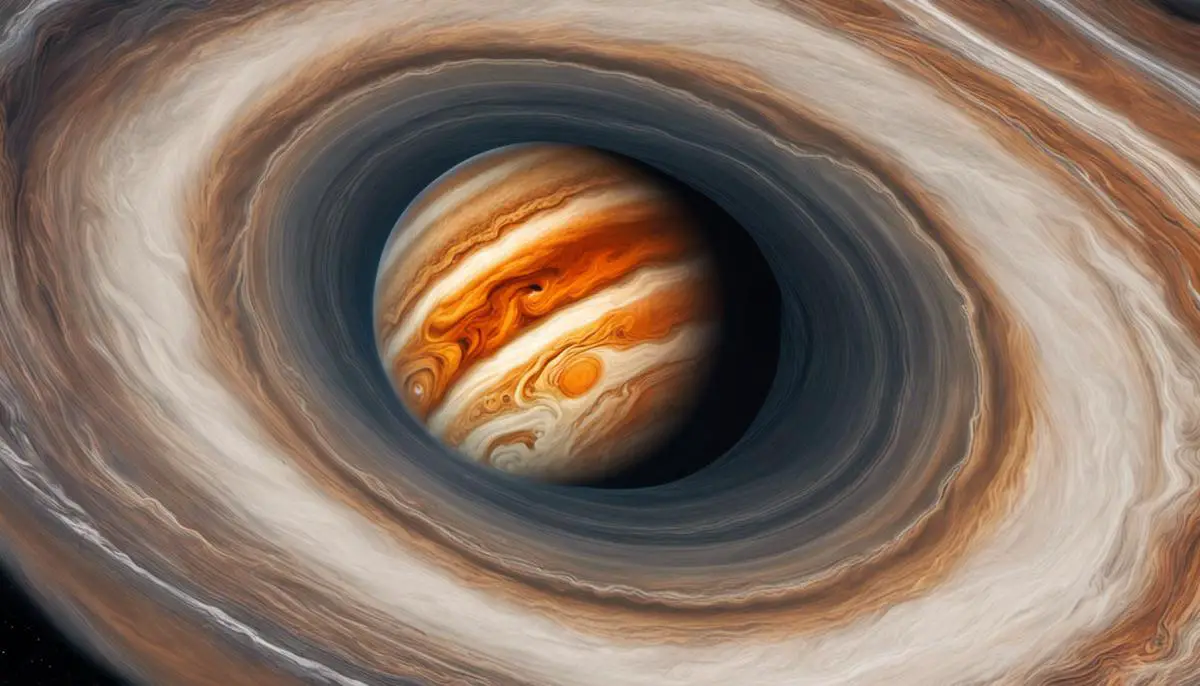The planet Jupiter, famous for its colossal size and vividly striped atmosphere, is home to one of the most phenomenal persistent meteorological phenomena in the solar system – the Great Red Spot (GRS). A storm of epic proportion, the GRS is an indispensable feature of Jupiter that significantly shapes the planet’s overall appearance and atmosphere. Known to mankind since the 17th century, this grandeur of a hurricane persistently whirls through the turbulent Jovian skies, withstanding the test of time. As we steer through this topic, we will illuminate the vastness of the GRS, the fascinating science that sustains it, its profound influences on Jupiter’s weather, atmospheric composition, and moons, as well as present research and future projections regarding this enigmatic storm.
Understanding Jupiter’s Storm
Understanding Jupiter’s Great Red Spot
Jupiter’s Great Red Spot, often referred to as the GRS, is primarily a high-pressure region in the atmosphere of Jupiter, producing an anticyclonic storm that has been persisting for at least 300 years and possibly longer. This storm is the most significant feature of the giant planet’s visible surface, and it’s known for its striking reddish appearance.
Discovery and Impact on Jupiter’s Appearance
The GRS was discovered in the 17th century, possibly as early as 1665 by Italian astronomer Giovanni Cassini, although its exact identification period is somewhat disputed among historians. Because of its observable red color, it has played a primary role in giving Jupiter its distinct visual identity.
Variations and Diminishing Size
Over the decades, several changes have been observed in the size, shape, and color of the hurricane. Since the 1800s, the size of the Great Red Spot has been shrinking. In the late 1800s, the storm was estimated to be about 25,475 miles (41,000 kilometers) in diameter, which could have fit four Earth diameters side by side. In 1979, when the Voyager space probes visited Jupiter, the spot had decreased to a diameter of 14,500 miles (23,335 kilometers). The most recent measurements have shown that it’s still shrinking, but the rate of shrinkage seems to be slowing down.
Varied Theories of the Storm’s Color
The distinct red color of Jupiter’s storm has intrigued scientists and researchers for years. Various theories have been proposed for the reddish color of the storm, with none as yet universally accepted. Some scientists propose that the color is caused by complex organic molecules, red phosphorus, or a compound containing sulfur. Others suggest that the red comes from below Jupiter’s cloud layer and is a reflection of the fiery core or possibly sunlight chemically interacting with Jupiter’s atmosphere.
Significance of the Great Red Spot in Attributing Jupiter’s Weather
The Great Red Spot (GRS), a vital feature in Jupiter’s atmosphere, plays a pivotal role in the planet’s climatic factors and weather system regulation. The GRS fuels sizeable planetary waves that drive Jupiter’s jet streams, with wind speeds reaching up to an estimated 400 miles per hour (644 kilometers per hour). These winds greatly influence the surrounding atmosphere, yet the storm’s core remains remarkably tranquil, potentially providing insights into Jupiter’s weather phenomena.
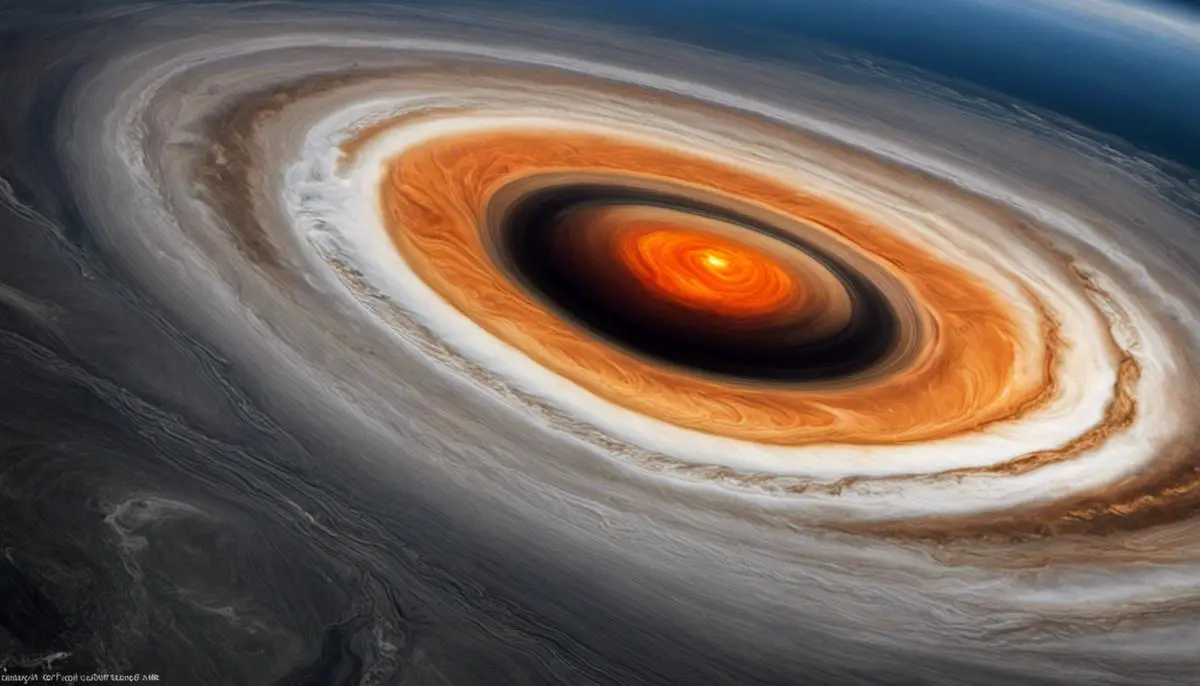
Size and Vital Statistics of the Great Red Spot
Unveiling the Scale of Jupiter’s Great Red Spot
The enormity and duration of the Great Red Spot (GRS) on Jupiter, a storm system under constant observation for nearly two centuries, significantly surpass any earthly hurricane. The GRS spans 10,000 miles in width, making it around 1.3 times the size of Earth. This massively contrasts with the average terrestrial hurricane width of only 300 miles, highlighting the sheer magnitude of the GRS.
Speed and Position of the Great Red Spot
The winds of the GRS, situated 22 degrees south of Jupiter’s equator, whirl at tremendous speeds, estimated to peak around 270 miles per hour. To give that a context, consider the highest wind speed ever recorded on Earth during a hurricane, which was approximately 200 miles per hour, during Hurricane Patricia in 2015. The average speed of an Earth-based hurricane tends to fall within 74 to 150 miles per hour, making the wind speeds of the GRS substantially more devastating.
Distinctive Appearance of the Great Red Spot
Given its notable reddish-orange coloration, the Great Red Spot is among the most distinguishing features of Jupiter. The striking color, however, is not entirely understood. Some scientists speculate that it could be due to complex organic molecules, red phosphorus, or perhaps sulfurous compounds. The colors tend to vary over time and might indicate different types of materials rising from within the storm.
Fluctuations in Size and Shape
While the size of the GRS remains impressively large compared to Earth, it is important to note that it has significantly reduced in size over time. Measurements taken in the late nineteenth century estimated it to be about 25,000 miles in diameter. Current measurements, although markedly smaller, still make it the largest storm in the solar system. The GRS’s shape, also dynamic, fluctuates between spherical and oval due to Jupiter’s turbulent and fast-moving atmosphere.
Jupiter’s Enormous Great Red Spot
Once you understand the sheer size of Jupiter, over 11 times the diameter of Earth, then the true scale of its centuries-old storm, the Great Red Spot, becomes genuinely apparent. There is no comparison to be found within the Earth’s meteorological record with respect to size, speed, or longevity. This storm offers a rare opportunity for scientists to study an enduring and complex atmospheric phenomenon, thus shedding light on the weather patterns of our solar system.
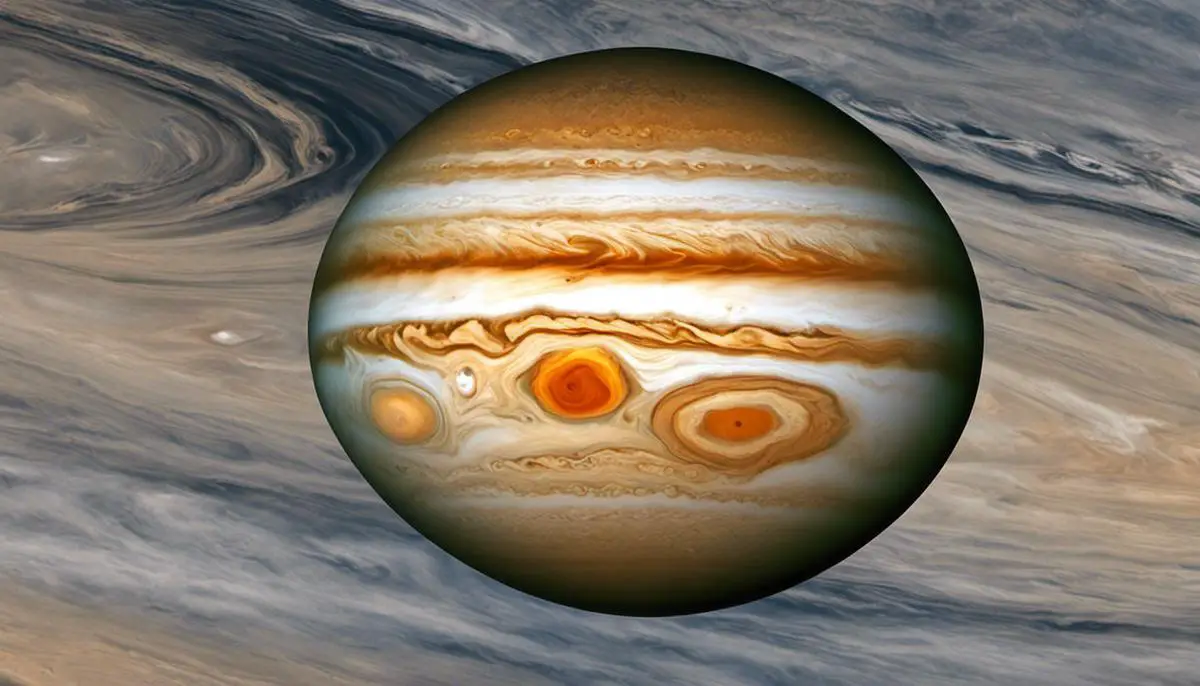
The Science Behind the Storm
Deciphering the Mysteries of the Great Red Spot
The Great Red Spot is no ordinary storm. It is the largest known in the entire solar system, almost 1.3 times the size of our home planet, Earth. Astonishingly, this storm has been persistently spiraling on Jupiter’s surface for a minimum of four centuries. Despite its awe-inspiring stature, it is its significant lifespan that leaves scientists contemplating how such a storm could maintain its vigour for such an extended period.
What Fuels the Great Red Spot?
Essentially, the Great Red Spot is powered by a complex combination of atmospheric phenomena and energy from the Sun. The storm is born from the differential rotation of Jupiter’s atmosphere – in other words, different zones of the planet’s atmosphere rotating at different speeds. This produces immense turbulence and swirling vortices, which can coalesce into much larger storms such as the Great Red Spot.
In addition, Jupiter’s internal heat is another key factor in fuelling the storm. Unlike Earth, where most weather systems are driven by the Sun’s heat, Jupiter generates more heat internally – about twice as much as it receives from the Sun. This heat rises through convective motion in the atmosphere and folds into the dynamics of the storm, keeping it alive.
Why Does It Resist Dissipation?
Now, the question arises: How can the storm resist dissipation? The answer lies again in the peculiarities of Jupiter’s atmosphere.
On Earth, storms lose energy when they come into contact with the land or polar regions, decreasing their ability to sustain themselves. However, on Jupiter, there is no land to slow down the storm and there is no comparable polar temperature gradient – which means the storm faces little to no friction. Therefore, it doesn’t lose energy like its terrestrial counterparts and thus, persists.
Also, the lack of viscous drag (friction) in Jupiter’s mostly gaseous atmosphere allows the wind flows around the Great Red Spot to preserve its vortex structure and, therefore, its energy.
The Size Factor: How Big Is It?
Despite the storm’s resilience, its size is not static. Measuring the size of the Great Red Spot is complex due to its irregular shape and the constant atmospheric changes on Jupiter. Nonetheless, recent estimations place the storm’s length at around 15,800 kilometers (roughly 1.3 times the diameter of Earth) and its width at about 10,940 kilometers.
The Great Red Spot, a centuries-old hurricane on Jupiter, has sustained its tremendous size over time due to a unique mixture of atmospheric conditions and the planet’s internal heating. These factors have not only thwarted its dissipation but also enabled it to stay in continuous agitation for hundreds of years.
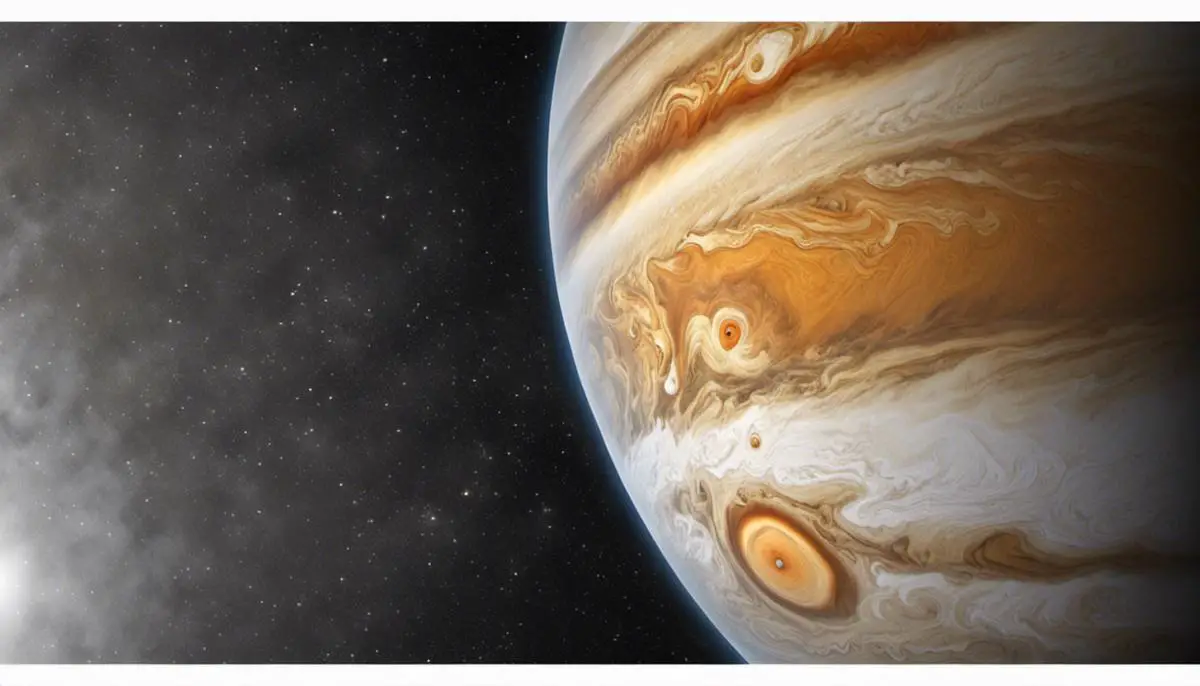
Effects on Jupiter’s Atmosphere and Moons
Understanding the Size and Dynamics of Jupiter’s Great Red Spot
Identified as the Great Red Spot (GRS), this mammoth storm seething on Jupiter could more aptly be compared to a colossal cyclone and has been in a perpetual state of swirling fury for centuries. This storm was closely observed by the Voyager spacecraft during the 1970s, shedding light on some of its features—gusts reaching speeds of 300 miles per hour, a staggering diameter of about 10,000 miles, and towering height of approximately 125 miles. To put this into perspective, its diameter is about 1.3 times that of Earth.
Influence on Jupiter’s Global Weather Patterns
The GRS is far from being just a meteorological curiosity on the surface of Jupiter—it plays a substantial role in the planet’s global weather patterns. The storm’s enormous size and energy create large waves and jet streams in Jupiter’s atmosphere that influence the global weather. The atmospheric flows around the GRS carry heat, momentum, and chemical species over extensive distances circulating around the planet.
Atmospheric Composition
The Great Red Spot also has an impact on the atmospheric composition of Jupiter. It acts as a blender, stirring the outer layers of Jupiter’s atmosphere with the deeper sections. The red color of the GRS is believed to result from these deeper atmospheric chemicals being dredged up and exposed to ultraviolet light from the sun. Spectroscopic analysis of the storm has revealed the presence of numerous exotic compounds such as phosphine and ammonia, which lends credibility to this theory.
Impacts on Jupiter’s Moons
While it’s less clear the extent to which the storm directly influences Jupiter’s numerous moons, the GRS’s strong magnetic field does have implications for the broader Jovian system. The GRS contributes to the overall magnetic field of Jupiter, which is known to have significant effects on its moons, especially Io, which experiences intense volcanic activity believed to be driven by magnetic interaction with Jupiter.
The Enduring Wonder of the Great Red Spot
For at least 150 years, possibly even longer, the Great Red Spot—Jupiter’s centuries-old hurricane—has maintained its reign. Even though its size and shape have evolved over time, the storm’s ferocity remains constant, marking it as one of the most prominent features of our Solar System. This testament to Jupiter’s atmospheric dynamism influences not only the planet’s weather patterns and atmospheric composition, but perhaps, its moons too. Yet, despite its salient impact, the Great Red Spot’s secrets largely remain unrevealed; it’s an intriguing stormy mystery.
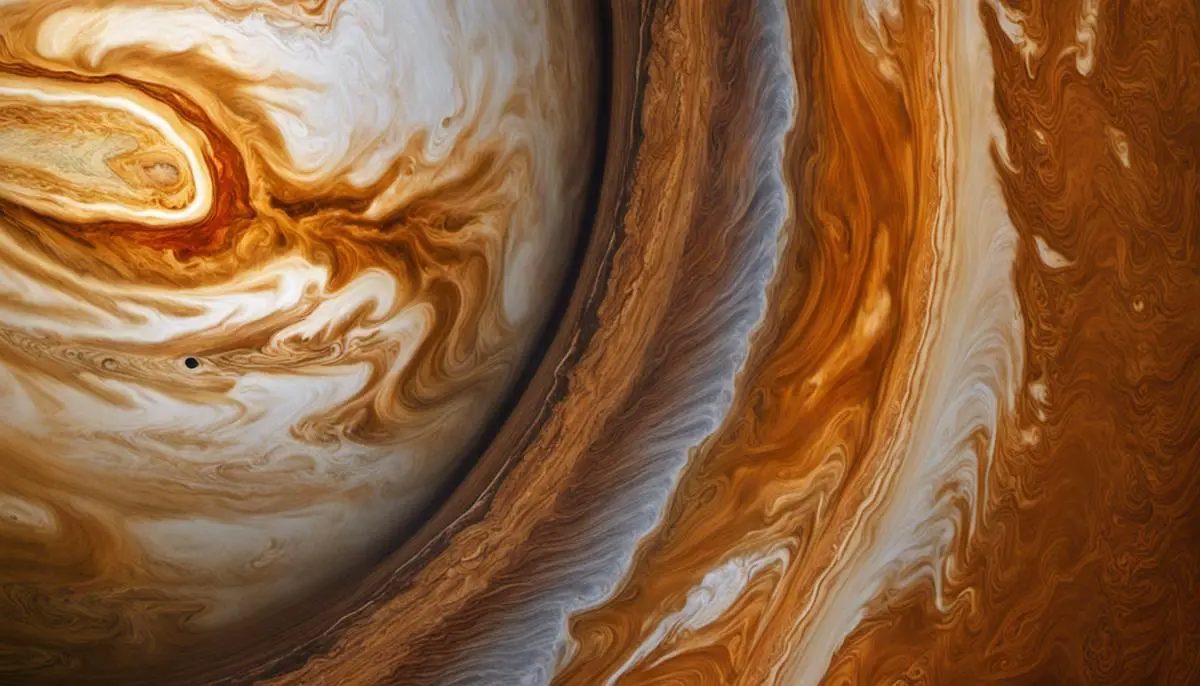
Future Projections and Research
Comprehending the Dimensions of Jupiter’s Great Red Spot
Staying alive for centuries, the Great Red Spot is specifically recognized for its distinctive red hue and gigantic size. This perpetual high-pressure area, spanning approximately 1.3 times the diameter of Earth, houses a cyclone that has been incessantly brewing in Jupiter’s atmosphere for no less than a century and a half, possibly even more. The breathtakingly high winds of the Great Red Spot put to shame any storm on Earth, racing at a velocity three times higher than Earth’s most powerful gusts.
NASA’s Space Missions and the Great Red Spot
Space missions have been pivotal in understanding the Great Red Spot’s vastness and anomalies. NASA’s Voyager 1 and 2, both launched in the late 1970s, provided the initial comprehensive data about the Jupiter anomaly. Two decades later, NASA’s Galileo orbiter further reinforced and supplemented the Voyager data with high-resolution, color images and detailed atmospheric analysis. More recently, the Juno mission continues to allow researchers unfounded insights into the storm, generating data about the storm’s extended lifespan, internal heat source, and extraordinary depth.
Unpredictable Changes
Over the past decades, significant changes have been noted in the Great Red Spot. NASA scientists have documented a gradual decrease in the storm’s size since the 1800s. At its largest, the Red Spot was four times the Earth’s diameter, but it is currently about 1.3 times the width of Earth. Observations also spot an intriguing color change, oscillating between deeper and lighter reds without a discernable pattern.
The Future of the Great Red Spot
Predicting changes in the Great Red Spot is far from straightforward due to the storm’s turbulent nature and the complexity of Jupiter’s atmosphere. While some researchers propose that the storm is dying due to the noticeable shrinkage, others challenge this view, highlighting that the Great Red Spot has shown periods of contraction followed by expansion in the past. Current research suggests that while the Great Red Spot is changing, it’s likely to persist for many years. However, further observation and analysis are required to garner a more comprehensive understanding of what lies ahead for Jupiter’s epic storm.
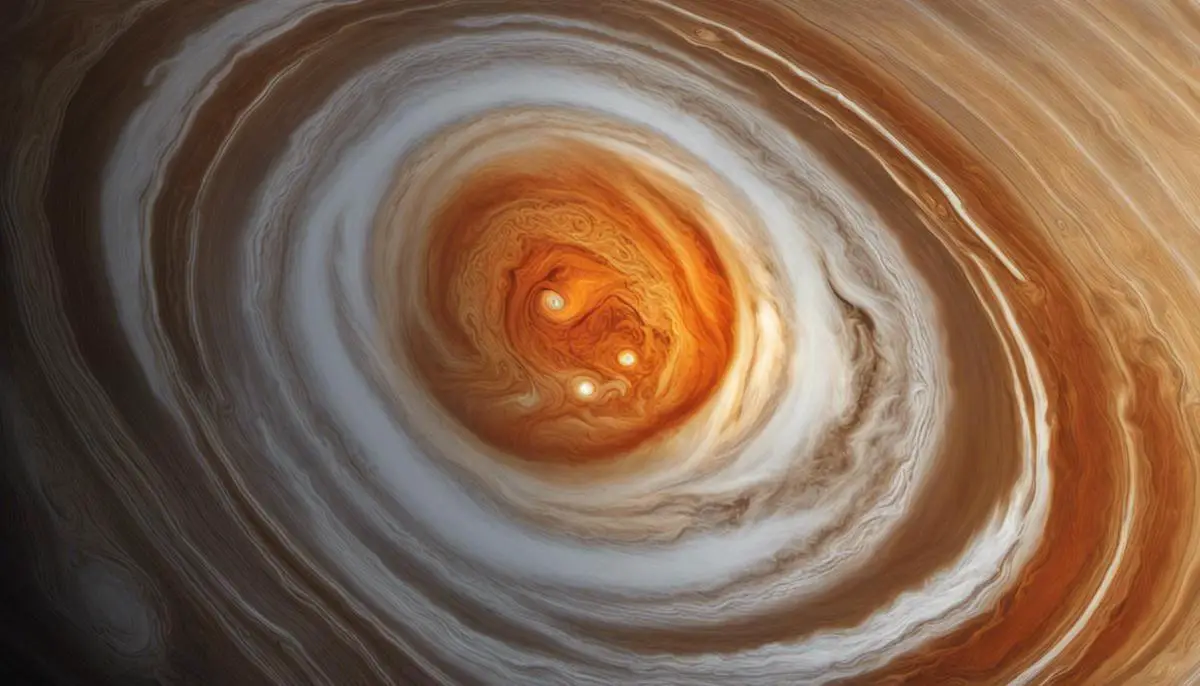
As an integral entity in the massive celestial body, the Great Red Spot’s magnitude and ceaseless existence mystify us while simultaneously providing essential insight into Jupiter’s atmospheric complexities. The storm’s statistics are staggering, its influences profound, and the science behind it is awe-inspiring. While much has been learned, countless mysteries surrounding this colossal hurricane are yet to be unraveled. For this reason, present and future endeavours to gather critical information about this storm prove to be promising undertakings. As we continue to push the frontiers of our knowledge about our solar system, the Great Red Spot stands as an enduring symbol of the wonder and enduring discoveries that await us.
![]()
